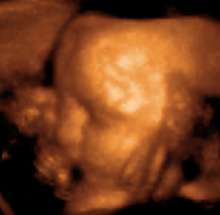Ultrasound

Ultrasound is sound with a frequency greater than the upper limit of human hearing, approximately 20 kilohertz (20,000 hertz). Some animals, such as dogs, dolphins, bats, and mice have an upper limit that is greater than that of the human ear and thus can hear ultrasound. Children can hear some high-pitched sounds that older adults cannot hear, as in humans the upper limit pitch of hearing gets lower with age. This frequency limit is caused by the middle ear that acts as a low-pass filter. If ultrasound is coupled directly into the skull bone and reaches the cochlea without passing through the middle-ear, much higher frequencies (up to about 200 kHz) will be audible. This effect (sometimes called ultrasonic hearing) was first discovered by divers exposed to a high-frequency (ca. 50 kHz) sonar signal.
Medical sonography
Medical ultrasonography (sonography) is an ultrasound-based diagnostic imaging technique used to visualize muscles and internal organs, their size, structure and any pathological lesions, making them useful for scanning the organs. Obstetric sonography is commonly used during pregnancy.
Other medical uses
Ultrasound also has therapeutic applications:-
- Treating benign and malignant tumors and other disorders, via a process known as Focused Ultrasound Surgery (FUS) or HIFU, High Intensity Focused Ultrasound. These procedures generally use lower frequencies than medical diagnostic ultrasound (from 250 kHz to 2000 kHz), but significantly higher time-averaged intensities. The treatment is often guided by MRI, as in Magnetic Resonance guided Focused Ultrasound.
- More powerful ultrasound sources may be used to clean teeth in dental hygiene or generate local heating in biological tissue, e.g. in physical therapy and cancer treatment.
- Focused ultrasound sources may be used to break up kidney stones or for cataract treatment by phacoemulsification.
- Additional physiological effects of low-intensity ultrasound have recently been discovered, e.g. the ability to stimulate bone-growth and its potential to disrupt the blood-brain barrier for drug delivery.
Ultrasonic cleaning
Ultrasonic cleaners, sometimes mistakenly called supersonic cleaners, are used at frequencies from 20-40 kHz for jewellery, lenses and other optical parts, watches, dental instruments, surgical instruments and industrial parts. The main mechanism for cleaning action in an ultrasonic cleaner is the energy released from the collapse of millions of microscopic cavitation events occurring near the dirty surface. The bubbles formed by cavitation colapse through themselves forming tiny jets direected at the surface. Home cleaners are available and costs range from approximately US $60.
Scaring rodents away
Ultrasound generator/speaker systems are sold with claims that they frighten away rodents and insects, but there is no scientific evidence that the devices work; controlled tests have shown that rodents quickly learn that the speakers are harmless. However, the pitch used is well within the audible range of most children, and can cause headaches.
There is sufficient evidence however, to show that ultrasound in the range that is emitted by bats has a definite effect on the direction chosen by moths to fly, as bats eat moths.
Sonochemistry
Power ultrasound in the 20-100 kHz range is used in chemistry. The ultrasound does not interact directly with molecules to induce the chemical change as its typical wavelength is too long compared to the size of molecules. Instead, cavitation causes local extremes of temperature an pressure in the liquind in which the reaction is performed. In addition, it also breaks up solids and removes passivating layers of inert material to give a larger surface area for the reaction to occur over. Both these factors lead to a general increase in the rate of reaction when ultrasound is used compared to when it is not.
Ultrasonic disintegration
Some sorts of ultrasound can disintegrate biological cells including bacteria. This has uses in biological science and in killing bacteria in sewage. See for example:-
- http://www.sanyogallenkamp.com/proddetail.asp?prodid=236
- http://www.iwaponline.com/wst/04209/wst042090073.htm
Ultrasound as a weapon
Other uses
Ultrasound when applied in specific configurations can produce exotic phenomena such as sonoluminescence. These phenomena are being investigated partly because of the possibility of bubble fusion (a nuclear fusion reaction hypothesized to occur during sonoluminescence).
A common use of Ultrasound is in range finding. The basic principle is that an ultrasonic pulse is generated in a particular direction. If there is an object in the path of this pulse, part or all of the pulse will be reflected back to the sender as an echo and can be detected.
By measuring the difference in time between the pulse being transmitted and the echo being received, it is possible to determine how far away the object is.
Bats use a variety of ultrasonic ranging (echolocation) to detect their prey. Sonar is another form.
See also
- Dog whistle
- Infrasound (sound at extremely low frequencies)
- Light
- Physics
